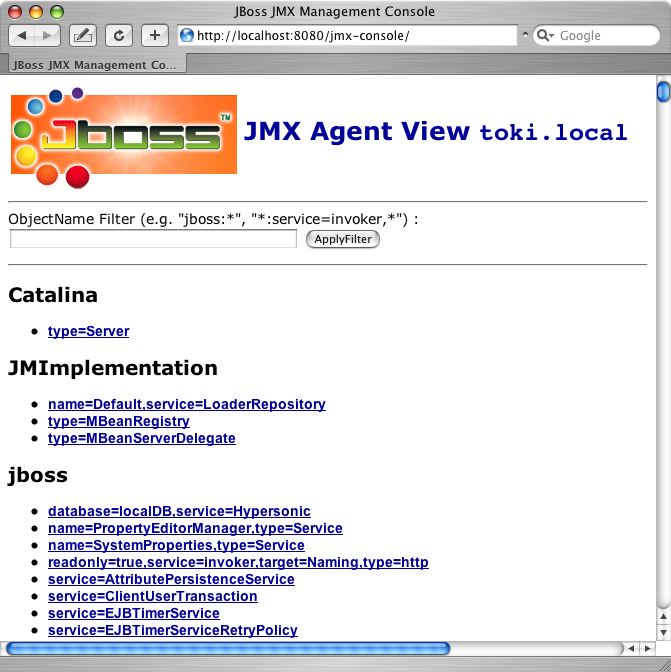How To Start Jboss Application Server In Windows
Affiliate 1. Getting Started
one.1. Downloading and Installing JBoss
The JBoss application server is available as a free download from the JBoss website. (http://www.jboss.org/downloads/alphabetize) We provide both a binary and source distribution, only if you lot are but getting started with JBoss, stick to the binary distribution, which can be run straight out of the box.
The binary versions are available as either .zippo, .tar.gz, .bz2 files. The contents are the same so catch whichever season is well-nigh convenient for the platform you're running on. Once information technology'due south downloaded, unpack the archive to a suitable location on your machine. It should all unpack into a single directory named jboss-4.0.ii. Of course the version number suffix will be different if you are running a later on release. Brand sure you don't use a directory which has whatsoever spaces in the path (such equally the Program Files directory on Windows) as this may cause bug.
The only boosted requirement to run JBoss is to have an up-to-appointment version of Coffee on your auto. JBoss iv.0 requires at to the lowest degree a Java 1.4 or Java i.5 JVM. (the JDK is no longer required to run JBoss) You lot should also make sure the JAVA_HOME environment variable is prepare to signal to your JDK installation.
1.2. Starting the Server
Our first step is to attempt running the server. Y'all'll find a bin directory inside the main JBoss directory which contains diverse scripts. Execute the run script (run.bat if you're on Windows, run.sh if you're on Linux, OS X, or another UNIX-like system). You should so see the log messages from all the JBoss components as they are deployed and started upward. The final message (obviously with different values for the time and showtime-upwardly speed) should expect like the following.
12:31:23,996 INFO [Server] JBoss (MX MicroKernel) [iv.0.2 (build: CVSTag=JBoss_4_0_2 appointment= 200504191712)] Started in 47s:608ms
You lot can verify that the server is running past going the JBoss web server, which is running on port 8080. (Make certain you don't accept annihilation else already on your machine using that port) The default folio has links to a few useful JBoss resources.
one.iii. The JMX Console
You can get a live view of the server past going to the JMX panel application at http://localhost:8080/jmx-panel [one]. You should see something similar to Effigy 1.1, "View of the JMX Direction Panel Spider web Application".
This is the JBoss Direction Panel which provides a raw view of the JMX MBeans which make up the server. Y'all don't actually need to know much about these to begin with, but they can provide a lot of information about the running server and allow you lot to modify its configuration, start and stop components and so on.
For case, find the service=JNDIView link and click on it. This particular MBean provides a service to let you to view the structure of the JNDI namespaces within the server. Now observe the operation called list well-nigh the bottom of the MBean view folio and click the invoke. The operation returns a view of the electric current names bound into the JNDI tree, which is very useful when yous get-go deploying your own applications and want to know why you can't resolve a particular EJB name.

Figure 1.one. View of the JMX Management Console Web Application
Look at some of the other MBeans and their listed operations; try changing some of the configuration attributes and see what happens. With a very few exceptions, none of the changes made through the console are persistent. The original configuration volition be reloaded when you restart JBoss, and so you can experiment freely and shouldn't be able to do any permanent damage.
1.4. Stopping the Server
To finish the server, you can blazon Ctrl-C or you can run the shutdown script (shutdown.bat or shutdown.sh) from the bin directory. Alternatively, you can use the management console. Expect for type=Server nether the jboss.system domain and invoke the shutdown functioning.
i.5. Running every bit a Service
In a real deployment scenario, you lot won't want to terminate and get-go JBoss manually just will desire it to run in the background as a service or daemon when the car is booted up. The details of how to practise this will vary between platforms and will require some arrangement administration knowledge and root privileges.
On Linux or other UNIX-similar systems, you will have to install a startup script (or get your system administrator to exercise it). There are examples in the JBoss bin directory chosen jboss_init_redhat.sh and jboss_init_suse.sh which y'all can modify and use. On a Windows organization, you can employ a utility like Javaservice[2] to manage JBoss as a system service.
Source: https://docs.jboss.org/jbossas/getting_started/v4/html/install.html
Posted by: taylorshantoote1978.blogspot.com

0 Response to "How To Start Jboss Application Server In Windows"
Post a Comment